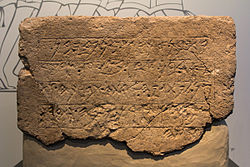 Global Information
Global InformationEkron Royal Dedicatory Inscription information
| Ekron inscription | |
|---|---|
 The inscription in its current location | |
| Material | Limestone |
| Size | H: 39; W: 60; D: 26 cm |
| Writing | Phoenician alphabet[1] |
| Created | first half of the 7th century BCE |
| Discovered | 1996 |
| Present location | Israel Museum |
| Identification | IAA 1997-2912 |
The Ekron Royal Dedicatory Inscription, or simply the Ekron inscription, is a royal dedication inscription found in its primary context,[2] in the ruins of a temple during the 1996 excavations of Ekron.[3] It is known as KAI 286.
It is incised on a rectangular-shaped limestone block with five lines and 71 characters,[1] and mentions Ekron, thus confirming the identification of the site, as well as five of its rulers, including Ikausu (Achish), son of Padi, who built the sanctuary. Padi and Ikausu are known as kings of Ekron from the late 8th- and 7th-century Neo-Assyrian Royal Annals.[4] King Padi is mentioned in connection to events from the years 701 and 699 BC, King Ikausu in relation to 673 and 667 BC, placing the date of the inscription firmly in the first half of the 7th century BC, and most likely in the second quarter of that century.[5]
It is the first connected body of text to be identified as "Philistine",[6] on the basis of Ekron's identification as a Philistine city in the Bible (see Joshua 13:3 and 1 Samuel 6:17). However, it is written in a Canaanite dialect similar to Phoenician and Old Byblian, such that its discoverers referred to it as "something of an enigma".[7][8]
- ^ a b Gitin, 1999, "The inscription is composed of five lines and seventy-one characters, written in a script similar to Phoenician, and to Old Hebrew, and is perhaps, as Naveh has suggested, a can- didate for a local late Philistine script."
- ^ Aaron Demsky (2007), Reading Northwest Semitic Inscriptions, Near Eastern Archaeology 70/2. Quote: "The first thing to consider when examining an ancient inscription is whether it was discovered in context or not. It is obvious that a document purchased on the antiquities market is suspect. If it was found in an archeological site, one should note whether it was found in its primary context, as with the inscription of King Achish from Ekron, or in secondary use, as with the Tel Dan inscription. Of course texts that were found in an archaeological site, but not in a secure archaeological context present certain problems of exact dating, as with the Gezer Calendar."
- ^ Gitin, Seymour (2003), Israelite and Philistine Cult and the Archaeological Record, in Symbiosis, Symbolism, and the Power of the Past, p. 287, "Two of the five names of city's rulers mentioned in the inscription - Padi and Ikausu - appear in the Neo-Assyrian Annals as kings of ‘amqar(r)una, that is, Ekron, an Assyrian vassal city-state in the 7th century B.C.E. (Gitin 1995: 62). Padi is known from the Annals of Sennacherib in the context of the Assyrian king's 701 B.C.E. campaign, at the end of which he gave the towns of the defeated Judean King Hezekiah to Padi and others (Pritchard 1969: 287-88). Padi is also cited in a docket dated to 699 B.C.E., according to which he delivered a light talent of silver to Sennacherib (Fales and Postgate 1995: 21-22). Ikausu is listed as one of the 12 coastal kings who transported building materials to Nineveh for the palace of Esarhaddon (680-669 B.C.E.), and his name also appears in a list of kings who participated in Ashurbanipal's first campaign against Egypt in 667 B.C.E. (Pritchard 1969: 291, 294)."
- ^ "Peter James, The Date of the Ekron Temple Inscription: A Note, in Israel Exploration Journal (IEJ), vol., 55 No. 1 (2005), p. 90" (PDF).
- ^ Gitin, Dothan, and Naveh, 1997, p. 15, quote: "Until now, the inscriptions found in Philistia have contained mainly proper names; hence, the Ekron dedication is the first fluent text containing two whole phrases"
- ^ Gitin, Dothan, and Naveh, 1997, p. 15, quote: "If so, one may ask why should a seventh century BCE inscription be written at Ekron in a language close to Phoenician and reminiscent of Old Byblian. Phoenician was the prestige language in the tenth and ninth century BCE. To find an inscription, however, in seventh century BCE Philistia, where a script from the Hebrew tradition was used, is something of an enigma."
- ^ Jaacob Callev, "The Canaanite Dialect of the Dedicatory Royal Inscription from Ekron".